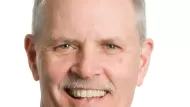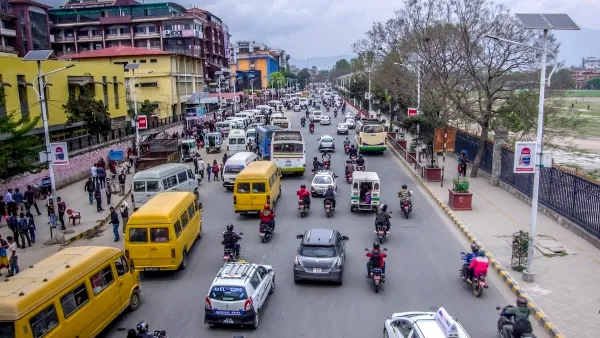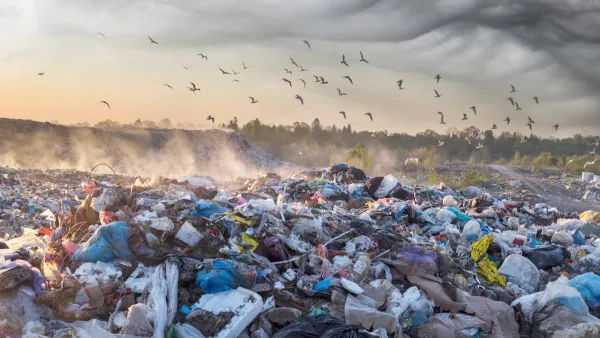Out in the bar, the world as we know it was coming to an end. In the backroom, meanwhile, smart people were trying to figure out the future of suburbia. The bar was in the lobby of a classic desert resort in Arizona. On the TV, CNN was delivering headlines of imminent doom. It was the last days of September, and the foundations of American finance were cracking under the strains of default and distrust.
Out in the bar, the world as we know it was coming to an end. In the backroom, meanwhile, smart people were trying to figure out the future of suburbia.
The bar was in the lobby of a classic desert resort in Arizona. On the TV, CNN was delivering headlines of imminent doom. It was the last days of September, and the foundations of American finance were cracking under the strains of default and distrust.
The people in the backroom were members of the Urban Land Institute (ULI) – 130 professionals whose business it was to design and build, under normal circumstances, the American Dream, western edition. They had come together not to respond to the crisis of the moment but to the crisis of the future. Their job was to creatively respond to the two inevitabilities they knew would change business as usual: more people and a warming climate.
In the next 30 years, 90 million more Americans will need somewhere to live, and many of them will choose the American West. Divide by 10, more or less, and assume the same for Canada. And then assume the climate will change.
On the morning of the second day, as Washington Mutual was collapsing live on the news channels, two scientists began the briefing. Their prognosis was unequivocal: given the carbon we have already emitted, the climate will change. The unknowns thereafter depend on our response – the changes we make in how we build and how we move.
Say this about the last half century of North American life: it's been the best that human beings have ever achieved, given our access to land, water, energy and money – unlimited in quantity, securely provided, cheap to afford. Ironically, of all those preconditions, money was thought to be the least problematic.
Four teams were charged with crafting new visions for sustainable development on the urban edge by balancing the demands of the market while reducing greenhouse gases and responding to rising energy prices. The ULI delegates weaved their way through the lobby on the way to their working groups, while on the TV the anchors could hardly keep up with developments about a financial system they could barely understand.
Themes emerged quickly: life would be more local, distances between destinations would be shorter, transportation options would be multiplied (winner of the most innovative option: the Flexhorse). There would be less waste of water, more solar energy, narrower streets, higher densities and a greater mix of uses.
The developers, architects and designers seemed as comfortable talking about net zero energy as net income. The checklists of sustainability and the nuances of LEED ratings were as familiar as pro formas. Green ideas had become boilerplate.
In truth, most of the renderings of the final products were also pretty familiar. Densities stayed low enough so that the production builders who provide most of the product (and who rarely attend ULI conferences) would not have to move too far from the single-family home or the townhouse. The task the ULI had undertaken could only deal with variations on existing suburban themes. In the end, the products for sale, the neighbourhoods envisioned and the urban regions extended had to be as aspirational and comfortable as any McMansion – just a hell of a lot greener.
It's the conundrum of our times. No plan for the future can ever say, in effect, that the assumptions on which our plans are based are likely to change due to some cataclysmic circumstance. Therefore, the conclusions are likely to be wrong and should be ignored. Instead, we have to plan as though the present will extend into the future along the same road we are already travelling, only in an electric car.
The TV in the bar was telling a very different story.
[From Business in Vancouver]

Planetizen Federal Action Tracker
A weekly monitor of how Trump’s orders and actions are impacting planners and planning in America.

Map: Where Senate Republicans Want to Sell Your Public Lands
For public land advocates, the Senate Republicans’ proposal to sell millions of acres of public land in the West is “the biggest fight of their careers.”

Restaurant Patios Were a Pandemic Win — Why Were They so Hard to Keep?
Social distancing requirements and changes in travel patterns prompted cities to pilot new uses for street and sidewalk space. Then it got complicated.

Platform Pilsner: Vancouver Transit Agency Releases... a Beer?
TransLink will receive a portion of every sale of the four-pack.

Toronto Weighs Cheaper Transit, Parking Hikes for Major Events
Special event rates would take effect during large festivals, sports games and concerts to ‘discourage driving, manage congestion and free up space for transit.”

Berlin to Consider Car-Free Zone Larger Than Manhattan
The area bound by the 22-mile Ringbahn would still allow 12 uses of a private automobile per year per person, and several other exemptions.
Urban Design for Planners 1: Software Tools
This six-course series explores essential urban design concepts using open source software and equips planners with the tools they need to participate fully in the urban design process.
Planning for Universal Design
Learn the tools for implementing Universal Design in planning regulations.
Heyer Gruel & Associates PA
JM Goldson LLC
Custer County Colorado
City of Camden Redevelopment Agency
City of Astoria
Transportation Research & Education Center (TREC) at Portland State University
Camden Redevelopment Agency
City of Claremont
Municipality of Princeton (NJ)






























